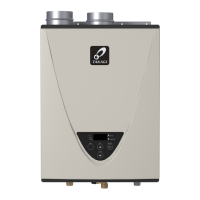13 Page
VENTING INSTRUCTIONS
For the 240 Indoor (T-H3J-DV), 340 Indoor (T-H3S-DV) and 540 Indoor (T-H3-DV) models
-General-
The Indoor models must be vented in accordance with the section “Venting of Equipment" of the latest
editionoftheNationalFuelGasCode:ANSIZ223.1/NFPA54intheUnitedStatesand/orSection7ofthe
CAN/CSAB149.1NaturalGasandPropaneInstallationCodeinCanada,aswellasapplicablelocalbuilding
codes.
The use of venting materials approved for Category III/IV appliances is recommended whenever possible.
However, the Indoor models may also be vented with plastic pipe materials such as ABS, PVC, CPVC, or
polypropylene. For details, please refer to the Exhaust Vent (ABS, PVC, CPVC, or Polypropylene Vent)
Section on p. 15. Vent installations in Canada which utilize plastic vent systems must use venting that
complieswithULCS636.
General rules for venting water heaters are:
• Place the water heater as close as possible to the vent termination.
• The vent collar of the water heater must be fastened directly to an unobstructed vent pipe.
• Do not weld the vent pipe to the water heater’s vent collar.
• Do not cut the vent collar of the unit.
• The vent must be easily removable from the top of the water heater for normal service and
inspection of the unit.
• The water heater vent must not be connected to any other gas appliance or vent stack except an
approvedcommon-ventingsystem.(Refertop.20and21.)
• Avoid using an oversized vent pipe or using extremely long runs of the pipe unless it is part of an
approved common vent system.
• For rooftop venting, a rain cap or other form of termination that prevents rain water from
entering into the water heater must be installed.
• Do not terminate vent into a chimney. If the vent must go through the chimney, the vent must
run all the way through the chimney with approved vent pipe.
General rules for vent terminations:
• Avoid locating the water heater vent termination near any air intake devices. These fans can
pick up the exhaust flue products from the water heater and return them to the building. This
can create a health hazard.
• Locate the vent termination so that it cannot be blocked by any debris, at any time. Most codes
require that the termination be at least 12 in. (305 mm) above grade, but the installer may
determine if it should be higher depending on the job site condition and applicable codes.
• A proper sidewall termination is recommended when the water heater is vented through a
sidewall.
• Regarding the clearances from the exhaust termination to the air inlet or opening, refer to p. 22
to 24.
• Improper venting of this appliance can result in excessive levels of carbon
monoxide which can result in severe personal injury or death.
• Improper installation can cause nausea or asphyxiation, severe injury or death
from carbon monoxide and flue gases poisoning. Improper installation will
void product warranty.
DANGER
When installing the vent system, all applicable national and local codes must be
followed. If you install thimbles, fire stops or other protective devices and they
penetrate any combustible or noncombustible construction, be sure to follow all
applicable national and local codes.
CAUTION
Installaon
Installaon Manual

